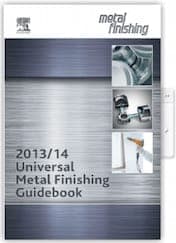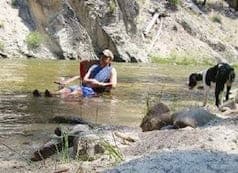
Curated with aloha by
Ted Mooney, P.E. RET

The authoritative public forum
for Metal Finishing 1989-2025

-----
Current Density Meter? Calculate/measure current density in electroplating?
Tip: Readers want to learn from Your Situation 🙂
(little can be learned from abstract questions, so many readers skip them)
Q. How to calculate anode current density and cathode current density.
How to calculate the current density for all plating baths?
- Namakkal, India
October 29, 2022
A. Hi jayaprakash. Anode current density is simply the applied current divided by the surface area of the anode. Cathode current density is simply the applied current divided by the surface area of the cathode.
You haven't introduced yourself or your situation yet, so unfortunately it is difficult to know if I'm understanding the question you are asking, but maybe you are asking what is the usual or maximum current density for all plating baths? It depends on the particular plating solution and the method of plating (rack, barrel, continuous, etc.), and the degree of agitation ... but for rack plating most plating solutions operate at about 20-30 amps per square foot cathode current density; 40 amps per square foot is typical for bright nickel plating; and 150-250 for chrome plating.
People want to maximize production, and in the general case you can't plate faster than this without introducing problems like burning.
Luck & Regards,

Ted Mooney, P.E. RET
Striving to live Aloha
finishing.com - Pine Beach, New Jersey
Q. I am JAYAPRAKASH and working in plating company. I need to solve some problems in plating baths; please support to do that.
I understand the message you sent sir, but I am plating SS304 material and how to solve the line mark issue after nickel plating.
How to calculate surface area of material with formula method?
How to calculate thickness plated to the substrate which is plated?
How to calculate Amp/hr reading?
How to decide that the current density is suitable for that material?
How to maintain Nickel bath and copper bath with required parameters?
- Karnataka, India
November 9, 2022
sometimes on
AbeBooks or Amazon
(affil links)

free pdf is currently available from academia.edu
A. Hi Jayaprakash. Your curiosity is appreciated, and your questions are very welcome! ... but it is probably not possible to answer them in the few paragraphs appropriate to a public forum :-(
1. Calculating the surface area is a question of geometry rather than plating. If you don't easily find tutorials on line, you can get a copy of Tom Rochester's "Surface Area formulas & Tables -- A Resource for Surface Finishers."
2. Sorry, I don't know if you are asking how to determine the thickness which you have actually plated (which is a whole science in itself) or whether you are asking how to determine what thickness you ought to specify and try to plate (which is again a whole science in itself).
3. Again, I don't know what you mean by "how to calculate Amp/hr reading". But you divide the amp-hours shown on your amp-hour meter by the surface area you plated to learn the amp-hrs you applied per square foot or per square decimeter of surface area.
4. You should be using proprietary process baths, and the supplier should be giving you a technical data sheet with at least a starting range for amps per square foot. I've already offered the general figure that 40 amps/sq. ft. for rack nickel plating is a good number, and probably 20-30 amps/sq.ft. for copper plating.
5. Download the Metal Finishing Guidebook and read the chapters on Copper plating and on Nickel plating; you should also at least glance through the rest of the book as a first step. Good luck.
Luck & Regards,

Ted Mooney, P.E. RET
Striving to live Aloha
finishing.com - Pine Beach, New Jersey
⇩ Related postings, oldest first ⇩
Q. We are going to plate (Ni + Au) parts of very complex shape and need to determine current density during plating with good accuracy. Is there any method or device to determine current density (or surface area of complex part, where there is difficulty to simply calculate it from dimensions)?
Thanks.
PRECIOSA - Jablonec n.N. , Czech Republik
2005
A. Hello Frantisek. Your options might include current density meters from such suppliers as Industrial Instruments Inc., or electrochemical software designed to model complex electroplating situations.
Or ... you can determine the surface area by performing some process which coats the surface with a uniform thickness coating -- such as immersion copper plating, electroless nickel plating, anodizing (if the substrate is aluminum), or electropainting -- and determine the volume of coating applied (such as by a strip-and-weigh) operation. Obviously, if you can apply 2 or more of these methods you will increase your confidence level. Good luck.

Ted Mooney, P.E.
Striving to live Aloha
finishing.com - Pine Beach, New Jersey
Need real-time current density meter
RFQ: Is there a commercial plating current density meter available that will measure current density on my parts real time?
thomas c [surname deleted for privacy by Editor]- new bern, North Carolina
2007
Ed. note: This RFQ is outdated, but technical replies are welcome, and readers are encouraged to post their own RFQs. But no public commercial suggestions please ( huh? why?).
Q. Dear sir,
We are doing non-cyanide cadmium plating on steel parts as per 15-5 ph steels as per BAC 5701. The quality assurance parameters says that cathode current density should be 2-20 ASF.The anode current density should be 5-45 ASF (amperes square feet). We want to know how to check these current densities. Can anyone guide me in this regard?
thanx,
PROJECT ENGINEER - Karachi, Sindh, Pakistan
2007
A. You can set the required current density by knowing first the area of the cathode (or anode), then multiply it to your desired current density. The product would be your current setting.
Franz Cantillano- Philippines
In a chromium electroplating process it says the cathode current density is 20-30 A/dm2. Does that mean I use 20-30 Amps per dm2? That seems too high if I have to use a 1/1 cathode anode ratio for the size bath I'm using.
Damian Gruenberg- Woodlake California
May 30, 2015
Current Density Meter for Anodizing
Q. Good day.
This is a question for all you avid readers/contributors to this great site.
I am looking for a current density meter to measure ASF for anodize/electroplating. I did find a contact.
"I3's CD200 Current Density Meter allows electroplaters to know exactly where on the work piece the material is being deposited, as well as the rate of deposit. A small toroidal current probe is placed inside the plating bath near the work piece. A digital display on the instrument indicates the current density at that point in A/ft2 or A/dm2. By Faraday's Law, this current density is directly proportional to the rate at which material is being deposited on the work piece."
The concept is wonderful, in that the test rack of known area and the ammeter are NOT required for ASF determination.
If something seems too good to be true - it usually is!
The fly in the ointment is - I am not getting any response from this contact.
Does anybody have ideas as who else to contact? I have tried as many as I could think of, all to no avail.
Looking forward to replies.
Regards,
Lab Tech - Whitby, On., Canada.
June 18, 2015
A. Hi Eric.
I3 (Industrial Instruments Inc.) was a husband & wife business, and a supporting advertiser of finishing.com. The wife became seriously ill in 2007. I, and apparently everyone else in the industry, quickly lost contact with them. Many people have been looking for them since 2008 and, to the best of my knowledge (which I would be delighted to update), the company does not exist. Further, to my knowledge, no manufacturer of current density meters of this sort for electroplating and anodizing exists in the world. Good luck.
Regards,

Ted Mooney, P.E.
Striving to live Aloha
finishing.com - Pine Beach, New Jersey
Q. Good day Ted.
Thank you for your very timely response. I have procured a listing of 22 potential suppliers, and have received 11 replies as negative. There was a firm, Amptron, who did indeed manufacture a meter, albeit an ammeter configuration, but, they too, also are no longer operating.
I am focusing on I3, as where was the origin of manufacture?
Thank you for your input.
Regards,
Lab Tech. - Whitby, On., Canada.
A. Hi Eric. I3 was run by Fred and Catherine Dyer and operated from Newport News VA and subsequently from Tazewell TN. It was apparently a successor to or a re-naming of QCI. I don't know whether the instruments were actually manufactured in the USA or imported.
Regards,

Ted Mooney, P.E. RET
Striving to live Aloha
finishing.com - Pine Beach, New Jersey
A. Although I've had no personal experience with this equipment, I am very familiar with the vendor. You could try the PASII-III from Anodizing USA.

Marc Green
anodizer - Boise, Idaho
![]() Good day Marc.
Good day Marc.
Thanx for the contact. I am using a rack with test panels of a known surface area and measuring with an ammeter to determine ASF. It is cumbersome to measure off the rack with the "clamp" while ramping, so I ran a lead to ramp control to measure off the lead as I am ramping.
I really liked the I3 meter, as the panels and ammeter are not required. Also I could use it for tin, cad, copper, etc., plating.
Thank you for your input Ted And Marc.
Regards,
Lab Tech. - Whitby, On. Can.
Q. Hello,
I wanted to design an inside cathode for our sulfuric acid anodizing bath by adding new cathodes. As you know, knowing the current density on the cathode is an important aspect in order to estimate the cathode surface area.
Can I ask what should be the normal current density on the cathode?
And should I consider the surface area of the whole package? (new cathode + old cathodes together) for estimating the new cathode surface area regarding the current density?
Best Regards
Payam
- Bielefeld Germany
May 15, 2018
A. Hi Payam. When you are trying to design auxiliary cathodes for better coverage in recesses, I don't think the correct order of things is to first determine the desired cathode current density and then try to make cathodes with the appropriate surface area. I think the correct order of things is to start by designing cathodes of the optimum size and shape to improve coverage in those recesses.
Unless you are planning on separate isolated power supplies for the main cathodes and the auxiliary cathodes (which sounds complicated, perhaps unnecessarily so), you would need to consider the total cathode area.
Electrochemical modeling software does exist which (as I understand it) uses finite element analysis to estimate the current density everywhere on the anode and cathode, but predicting what those results will be would require that analysis software :-)
We appreciate the information provided, which gives us a good general understanding of what you are up to, but additional info about what problem you are experiencing and trying to address might be helpful. Good luck.
Regards,

Ted Mooney, P.E. RET
Striving to live Aloha
finishing.com - Pine Beach, New Jersey
Q, A, or Comment on THIS thread -or- Start a NEW Thread
